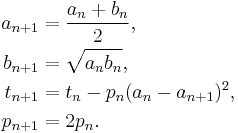Gauss–Legendre algorithm
The Gauss–Legendre algorithm is an algorithm to compute the digits of π. It is notable for being rapidly convergent, with only 25 iterations producing 45 million correct digits of π. However, the drawback is that it is memory intensive and it is therefore sometimes not used over Machin-like formulas.
The method is based on the individual work of Carl Friedrich Gauss (1777–1855) and Adrien-Marie Legendre (1752–1833) combined with modern algorithms for multiplication and square roots. It repeatedly replaces two numbers by their arithmetic and geometric mean, in order to approximate their arithmetic-geometric mean.
The version presented below is also known as the Brent–Salamin (or Salamin–Brent) algorithm; it was independently discovered in 1975 by Richard Brent and Eugene Salamin. It was used to compute the first 206,158,430,000 decimal digits of π on September 18 to 20, 1999, and the results were checked with Borwein's algorithm.
Contents |
Algorithm
1. Initial value setting:
2. Repeat the following instructions until the difference of  and
and  is within the desired accuracy:
is within the desired accuracy:
3. π is then approximated as:
The first three iterations give (approximations given up to and including the first incorrect digit):
The algorithm has second-order convergent nature, which essentially means that the number of correct digits doubles with each step of the algorithm.
Mathematical background
Limits of the arithmetic-geometric mean
The arithmetic-geometric mean of two numbers, a0 and b0, is found by calculating the limit of the sequences
which both converge to the same limit. If  and
and  then the limit is
then the limit is  where
where  is the complete elliptic integral of the first kind
is the complete elliptic integral of the first kind
If  ,
,  . then
. then
where  is the complete elliptic integral of the second kind:
is the complete elliptic integral of the second kind:
Gauss knew of both of these results.[1] [2] [3]
Legendre’s identity
For  and
and  such that
such that  Legendre proved the identity:
Legendre proved the identity:
Gauss–Legendre method
The values  can be substituted into Legendre’s identity and the approximations to K, E can be found by terms in the sequences for the arithmetic geometric mean with
can be substituted into Legendre’s identity and the approximations to K, E can be found by terms in the sequences for the arithmetic geometric mean with  and
and  .[1]
.[1]
See also
References
- ^ a b c Brent, Richard (1975), Traub, J F, ed., "Multiple-precision zero-finding methods and the complexity of elementary function evaluation", Analytic Computational Complexity (New York: Academic Press): 151–176, http://wwwmaths.anu.edu.au/~brent/pub/pub028.html, retrieved 8 September 2007
- ^ Salamin, Eugene. Computation of pi, Charles Stark Draper Laboratory ISS memo 74–19, 30 January, 1974, Cambridge, Massachusetts
- ^ Salamin, Eugene (1976), "Computation of pi Using Arithmetic-Geometric Mean", Mathematics of Computation 30 (135): 565–570, ISSN 0025--5718










